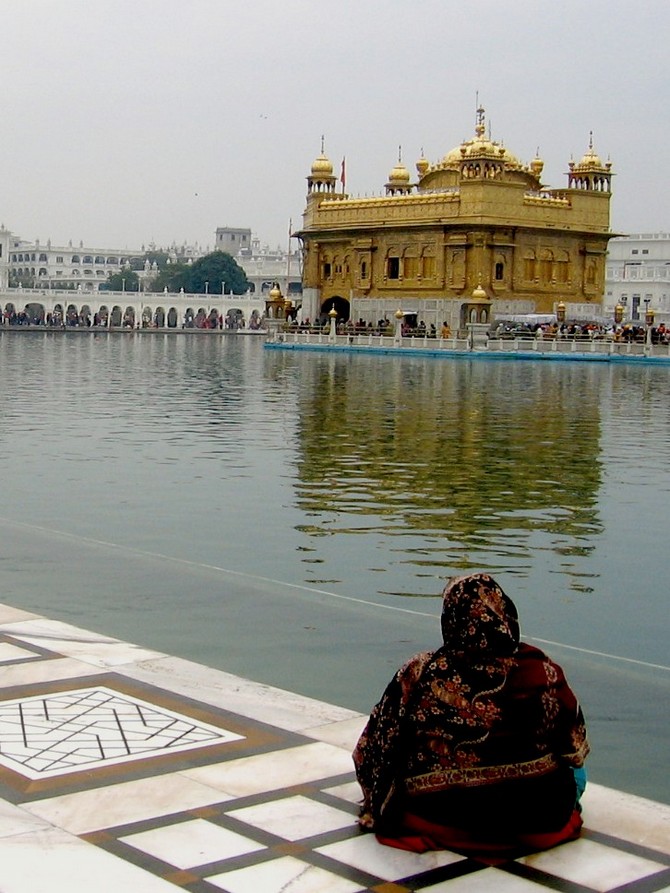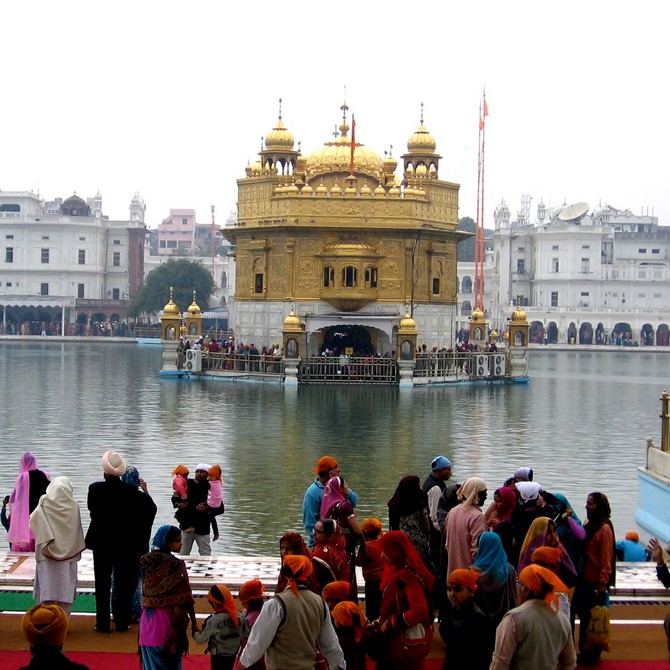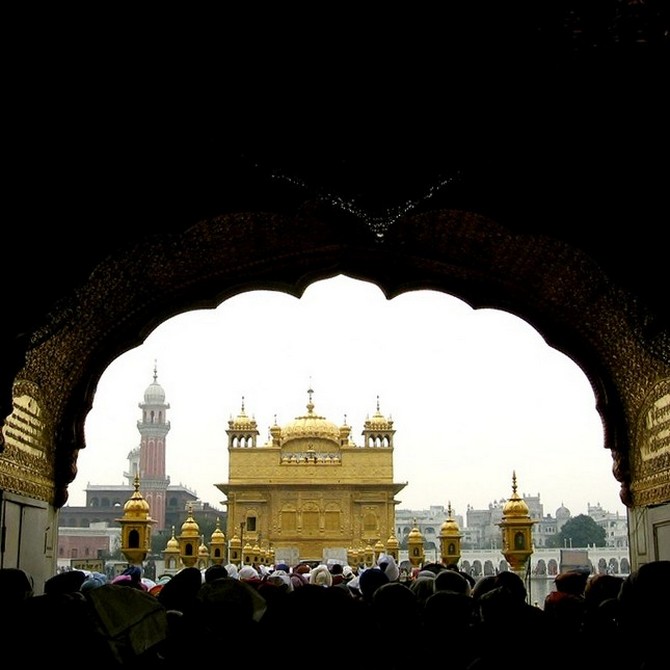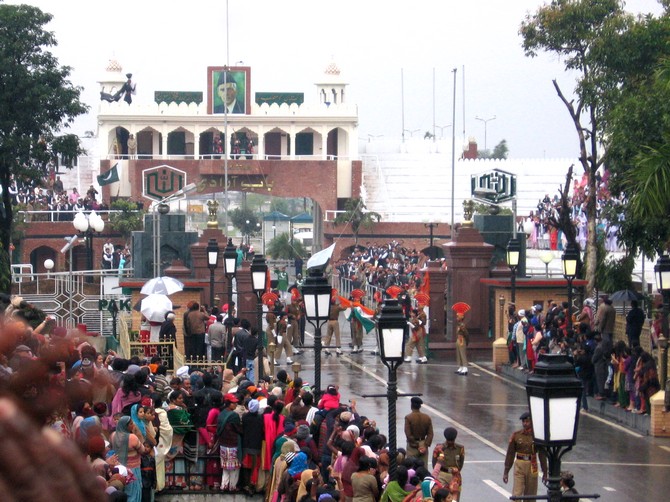 | « Back to article | Print this article |
1406 km through Punjab: Finding bliss in Amritsar
Here is part three of Deepak Kirpalani's Punjab travelogue.
Read part one here: Five Days and 1406 km through Punjab
Part two here: In the city of the magician
Part four here: A pilgrimage of another kind
Part five here: Stories of valour and sacrifice
The Golden Temple (correctly known as Harmandir Sahib and Darbar Sahib) (2132-2149) must rank among the most awe-inspiring spiritual destinations anywhere. The expanse, the symmetry, the visual impact of white marble and the sheer simplicity of it all, evoke such emotion. A grey sky and a light drizzle added a dimension we hadn't come across in images of the temple seen over the years.
The temple was built on a plot of land gifted by Emperor Akbar to the third Guru, Amar Das' daughter Bhani on her marriage to Bhai Jetha who became the fourth Guru, Ram Das. In 1577 Guru Ram Das excavated a tank which eventually gave the city its name (the pool of nectar).
Construction of the temple was completed by the fifth Guru, Arjan Dev. After compiling the Adi Granth in 1604, Guru Arjan Dev placed it in the newly constructed gurudwara. The Adi Granth, the first compilation of the teachings of the Gurus and other saints, would be placed on Guru Arjan Dev's bed during the night with the Guru himself resting on a sheet spread on the floor beneath it.
1406 km through Punjab: Finding bliss in Amritsar
To this day, between 11 pm and 3 am, the holy book is brought from the sanctum sanctorum and placed on the fifth Guru's bed in the Akal Takht, the seat of temporal authority at the northern end of the complex. A sheet is placed on the floor as a mark of reverence for the compiler of the holy text.
The sanctum sanctorum is a beautiful twin-storey structure with floral patterns etched on the marble wall. The devout sit within the building as also in the passage outside listening to the recitation of the Guru Granth Sahib seated there. A similar arrangement is followed on the first floor and the terrace. The first floor has an opening that allows a view of the holy book on the ground floor.
The sense of decorum, discipline and service came as a culture shock in a country where indiscipline and a complete lack of responsibility in public places is the norm. People patiently awaited their turn on the causeway leading to the sanctum sanctorum. No pushing or trying to squeeze ahead. No shouting either.
1406 km through Punjab: Finding bliss in Amritsar
About 25 people were let in at roughly five-minute intervals to ensure sufficient room for those inside. I was so completely taken by surprise when a lady gave me a plastic pouch to carry the karhan prasad that I forgot to thank her. It wasn't a one-off incident. The next morning as I came out of the causeway, someone handed me a cloth bag for the saropa to ensure it remained unsoiled.
Sensing that we were tourists, one of the marshals suggested that I safeguard my backpack against pickpockets by strapping it to my chest. Relays of volunteers are forever engaged in keeping the premises spotlessly clean. The determined look on their faces gave me the impression that they would willingly scrub the entire complex to a shine if asked to do so.
We circumambulated the pool, sprinkled some of its water on our head, partook of the langar and saw the slab of granite from the Mughal throne, brought from the Red Fort, Delhi in chains in 1783 as retribution for death sentences pronounced on and edicts for conversion issued to Sikhs and Hindus by Mughal rulers while seated on it. More inspiration was in the offing at the Central Sikh Museum on the first floor of the main entrance. The history of the community is one of struggle and sacrifice for an honourable way of life for all, regardless of religious persuasion. We had spent half the day at the temple. It didn't seem enough.
1406 km through Punjab: Finding bliss in Amritsar
It was a full house at the Lowering of the Flags ceremony at the Wagah border later in the day. Often described as the Berlin Wall of Asia, the border is 31 km from Amritsar and 23 km from Lahore. The road runs almost straight and large stretches of farmland separate pockets of habitation that appear with diminishing frequency. The last half kilometre through Customs, Immigration and Security has to be covered on foot.
A double iron fence runs as far as the eye can see some distance inside Indian Territory. The Customs area was filled with cargo bearing trucks awaiting clearance to cross into Pakistan. A bus carrying passengers to the other side inched its way past us. About 2000 spectators filled the stands on the Indian side. The Pakistani side had fewer visitors. I wondered why. Realisation struck during the build up to the actual ceremony.
The ceremony conducted by the Border Security Force and Pakistan Rangers runs for about 45 minutes but the build up begins about 45 minutes earlier. Cries of Bharat Mata Ki Jai, Vande Mataram and Hindustan Zindabad fill the air.
Patriotic songs blare from the public address system. Women are allowed to come down from the stands, dance and run to the border gate carrying the tricolour. And that's when the Eureka moment struck!
The Indian stands were full, women were dancing oblivious to the presence of hundreds of strangers and everyone present was enjoying the moment despite the steady drizzle and the cold, because it was a celebration of all that India stands for.
We have far more to be proud of than the people on the other side of the fence. The confidence, the pride and most importantly the freedom our way of life gives us, found expression in these spontaneous acts of joy. At the conclusion of the ceremony, spectators are allowed to walk to within a few feet of the gate on the Indian side.
***
Never had I seen parathas being crumpled like a ball of paper before being served. They do so at Kesar Da Dhaba located in a maze of narrow lanes in Bazar Passian in the old city.
With ghee being used as if it were going out of style, you could cup your palms and lick it as it drips from the paratha. Another memorable stop was Gurudas Ram Mithaiwala at Jalebi Chowk.
The two-men team makes jalebis all evening and well into the night to cater to the constant flow of customers. Sensing that we were visitors, the proprietor suggested that we buy a cupful for Rs 10 to begin with.
The smile on his faced revealed that he knew what was coming next. I guess that came from years of serving patrons from far and near. Sure enough, we repeated the order.
In Amritsar, go with the flow. Don't question. Eat. Eat some more. Because good food is a time-tested path to bliss!



